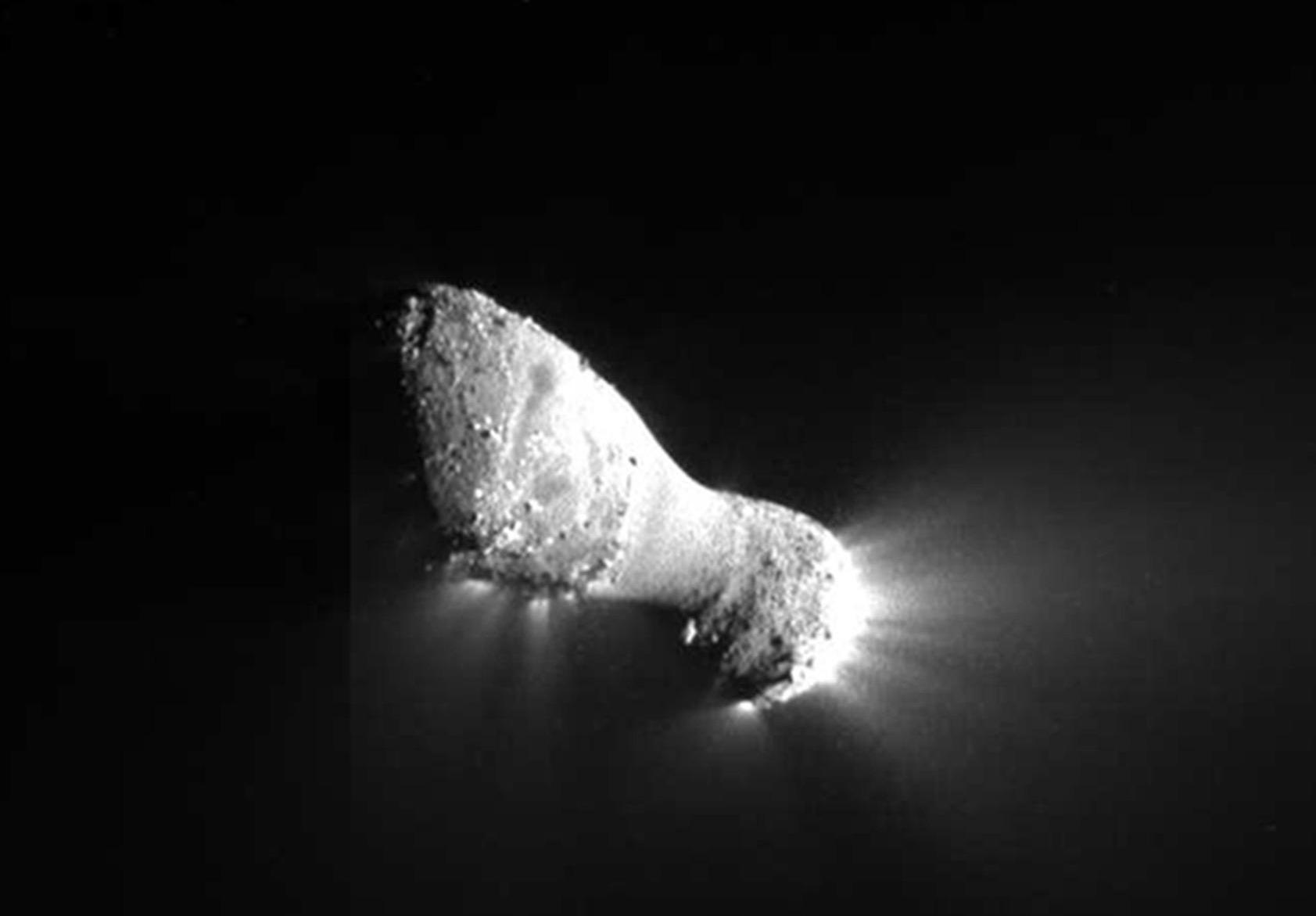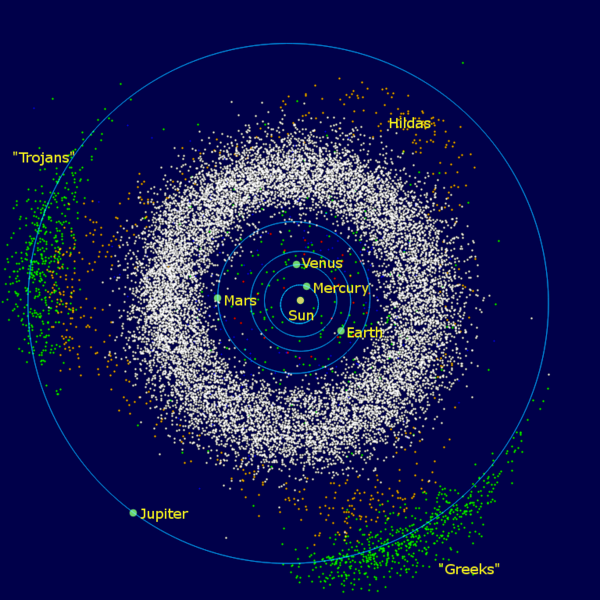|
Comet Boethin
Comet Boethin (officially 85D/Boethin) was a periodic Jupiter-family comet discovered in 1975 by Leo Boethin. It appeared again in January 1986 as expected. Although the comet was next expected at perihelion in April 1997, no observations were reported, and the comet is thought to have disintegrated. It has not been observed since March 1986. The comet might have come to perihelion in late July 2020, but the uncertainty in the comet's position is hundreds of millions of km. The old orbit would have the comet next coming to perihelion around November 2031. Discovery circumstances The comet was discovered under unusual circumstances. Comet 85D/Boethin was the first comet discovered by an observer in the Philippines. Leo Boethin (1912-1998), who was assigned as Reverend of the Abra province in 1949, had taken advantage of the exceptionally dark skies of Luzon to observe comets and meteor showers. In January 1973, he found his first suspected comet at magnitude 9.5, but he saw it f ... [...More Info...] [...Related Items...] OR: [Wikipedia] [Google] [Baidu] |
Julian Date
The Julian day is the continuous count of days since the beginning of the Julian period, and is used primarily by astronomers, and in software for easily calculating elapsed days between two events (e.g. food production date and sell by date). The Julian period is a chronological interval of 7980 years; year 1 of the Julian Period was . The Julian calendar year is year of the current Julian Period. The next Julian Period begins in the year . Historians used the period to identify Julian calendar years within which an event occurred when no such year was given in the historical record, or when the year given by previous historians was incorrect. The Julian day number (JDN) is the integer assigned to a whole solar day in the Julian day count starting from noon Universal Time, with Julian day number 0 assigned to the day starting at noon on Monday, January 1, 4713 BC, proleptic Julian calendar (November 24, 4714 BC, in the proleptic Gregorian calendar), a date at ... [...More Info...] [...Related Items...] OR: [Wikipedia] [Google] [Baidu] |
IAU Circular
The International Astronomical Union Circulars (IAUCs) are notices that give information about astronomical phenomena. IAUCs are issued by the International Astronomical Union's Central Bureau for Astronomical Telegrams (CBAT) at irregular intervals for the discovery and follow-up information regarding such objects as planetary satellites, novae, supernovae, and comets. History The first series of IAUCs was published at Uccle during 1920–1922 when the IAU's first CBAT was located there; the first IAUC published in the present series was published in 1922 at Copenhagen Observatory after the transfer of the CBAT from Uccle to Copenhagen. At the end of 1964, the CBAT moved from Copenhagen to the Smithsonian Astrophysical Observatory in Cambridge, Massachusetts, where it remains, on the grounds of the Harvard College Observatory (HCO). HCO had maintained a Central Bureau for the Western hemisphere from 1883 until the end of 1964, when its staff took on the IAU's CBAT; HCO h ... [...More Info...] [...Related Items...] OR: [Wikipedia] [Google] [Baidu] |
Lost Comets
A lost comet is one which was not detected during its most recent perihelion passage. This generally happens when data is insufficient to reliably calculate the comet's location or if the solar elongation is unfavorable near perihelion passage. The ''D/'' designation is used for a periodic comet that no longer exists or is deemed to have disappeared. Lost comets can be compared to lost asteroids (lost minor planets), although calculation of comet orbits differs because of nongravitational forces, such as emission of jets of gas from the nucleus. Some astronomers have specialized in this area, such as Brian G. Marsden, who successfully predicted the 1992 return of the once-lost periodic comet Swift–Tuttle. Overview Loss There are a number of reasons why a comet might be missed by astronomers during subsequent apparitions. Firstly, cometary orbits may be perturbed by interaction with the giant planets, such as Jupiter. This, along with nongravitational forces, can result i ... [...More Info...] [...Related Items...] OR: [Wikipedia] [Google] [Baidu] |
Periodic Comets
Periodicity or periodic may refer to: Mathematics * Bott periodicity theorem, addresses Bott periodicity: a modulo-8 recurrence relation in the homotopy groups of classical groups * Periodic function, a function whose output contains values that repeat periodically * Periodic mapping Physical sciences * Periodic table of chemical elements * Periodic trends, relative characteristics of chemical elements observed * Redshift periodicity, astronomical term for redshift quantization Other uses * Fokker periodicity blocks, which mathematically relate musical intervals * Periodic acid, a compound of iodine * Principle of periodicity, a concept in generally accepted accounting principles * Quasiperiodicity, property of a system that displays irregular periodicity See also * Aperiodic (other) * Cycle (other) * Frequency (other) * Period (other) Period may refer to: Common uses * Era, a length or span of time * Full stop (or period ... [...More Info...] [...Related Items...] OR: [Wikipedia] [Google] [Baidu] |
Astronomical Naming Conventions
In ancient times, only the Sun and Moon, a few stars, and the most easily visible planets had names. Over the last few hundred years, the number of identified astronomical objects has risen from hundreds to over a billion, and more are discovered every year. Astronomers need to be able to assign systematic designations to unambiguously identify all of these objects, and at the same time give names to the most interesting objects, and where relevant, features of those objects. The International Astronomical Union (IAU) is the recognized authority in astronomy for assigning designations to celestial bodies such as stars, planets, and minor planets, including any surface features on them. In response to the need for unambiguous names for astronomical objects, it has created a number of systematic naming systems for objects of various sorts. Stars There are no more than a few thousand stars that appear sufficiently bright in Earth's sky to be visible to the naked eye. This repre ... [...More Info...] [...Related Items...] OR: [Wikipedia] [Google] [Baidu] |
103P/Hartley
Comet Hartley 2, designated as 103P/Hartley by the Minor Planet Center, is a small periodic comet with an orbital period of 6.46 years. It was discovered by Malcolm Hartley in 1986 at the Schmidt Telescope Unit, Siding Spring Observatory, Australia. Its diameter is estimated to be . Hartley 2 was the target of a flyby of the Deep Impact spacecraft, as part of the EPOXI mission, on 4 November 2010, which was able to approach within of Hartley 2 as part of its extended mission. Hartley 2 is the smallest comet which has been visited. It is the fifth comet visited by spacecraft, and the second comet visited by the Deep Impact spacecraft, which first visited comet Tempel 1 on 4 July 2005. Discovery and orbit Comet Hartley 2 is a small Jupiter-family comet having an orbital period of 6.46 years. It was discovered by Malcolm Hartley in 1986 at the Schmidt Telescope Unit, Siding Spring Observatory, Australia. It has the perihelion near the Earth's orbit at 1.05 AU from th ... [...More Info...] [...Related Items...] OR: [Wikipedia] [Google] [Baidu] |
EPOXI
''EPOXI'' was a compilation of NASA Discovery program missions led by the University of Maryland and principal investigator Michael A'Hearn, with co-operation from the Jet Propulsion Laboratory and Ball Aerospace. ''EPOXI'' uses the '' Deep Impact'' spacecraft in a campaign consisting of two missions: the ''Deep Impact Extended Investigation'' (DIXI) and ''Extrasolar Planet Observation and Characterization'' (EPOCh). ''DIXI'' aimed to send the ''Deep Impact'' spacecraft on a flyby of another comet, after its primary mission was completed in July 2005, while ''EPOCh'' saw the spacecraft's photographic instruments as a space observatory, studying extrasolar planets. ''DIXI'' successfully sent the ''Deep Impact'' spacecraft on a flyby of comet Hartley 2 on November 4, 2010, revealing a "hyperactive, small and feisty" comet, after three gravity assists from Earth in December 2007, December 2008 and June 2010. The ''DIXI'' mission was not without problems, however; the spacecraft had ... [...More Info...] [...Related Items...] OR: [Wikipedia] [Google] [Baidu] |
NASA
The National Aeronautics and Space Administration (NASA ) is an independent agency of the US federal government responsible for the civil space program, aeronautics research, and space research. NASA was established in 1958, succeeding the National Advisory Committee for Aeronautics (NACA), to give the U.S. space development effort a distinctly civilian orientation, emphasizing peaceful applications in space science. NASA has since led most American space exploration, including Project Mercury, Project Gemini, the 1968-1972 Apollo Moon landing missions, the Skylab space station, and the Space Shuttle. NASA supports the International Space Station and oversees the development of the Orion spacecraft and the Space Launch System for the crewed lunar Artemis program, Commercial Crew spacecraft, and the planned Lunar Gateway space station. The agency is also responsible for the Launch Services Program, which provides oversight of launch operations and countdown m ... [...More Info...] [...Related Items...] OR: [Wikipedia] [Google] [Baidu] |
Jupiter Trojans
The Jupiter trojans, commonly called trojan asteroids or simply trojans, are a large group of asteroids that share the planet Jupiter's orbit around the Sun. Relative to Jupiter, each trojan librates around one of Jupiter's stable Lagrange points: either ', existing 60° ahead of the planet in its orbit, or ', 60° behind. Jupiter trojans are distributed in two elongated, curved regions around these Lagrangian points with an average semi-major axis of about 5.2 AU. The first Jupiter trojan discovered, 588 Achilles, was spotted in 1906 by German astronomer Max Wolf. More than 9,800 Jupiter trojans have been found . By convention, they are each named from Greek mythology after a figure of the Trojan War, hence the name "trojan". The total number of Jupiter trojans larger than 1 km in diameter is believed to be about , approximately equal to the number of asteroids larger than 1 km in the asteroid belt. Like main-belt asteroids, Jupiter trojans form families. , man ... [...More Info...] [...Related Items...] OR: [Wikipedia] [Google] [Baidu] |
56P/Slaughter–Burnham
56P/Slaughter–Burnham is a periodic comet in the Solar System with a period of 11.54 years. It was discovered in 1959 by Charles D. Slaughter and Robert Burnham of the Lowell Observatory Lowell Observatory is an astronomical observatory in Flagstaff, Arizona, United States. Lowell Observatory was established in 1894, placing it among the oldest observatories in the United States, and was designated a National Historic Landmark ..., Flagstaff, Arizona during a photographic survey. They spotted the comet, with a faint brightness of magnitude 16, on a plate exposed on 10 December 1958. By monitoring its movement over a series of consecutive days, Elizabeth Roemer was able to calculate its orbit, suggesting a perihelion date of 4 August 1958 and an orbital period of 11.18 years. It was subsequently observed in 1970, 1981, 1993, 2005 and 2016. Its next perihelion will be on December 19, 2027. References External links Orbital simulationfrom JPL (Java) Horizons Ephem ... [...More Info...] [...Related Items...] OR: [Wikipedia] [Google] [Baidu] |
Orbital Resonance
In celestial mechanics, orbital resonance occurs when orbiting bodies exert regular, periodic gravitational influence on each other, usually because their orbital periods are related by a ratio of small integers. Most commonly, this relationship is found between a pair of objects (binary resonance). The physical principle behind orbital resonance is similar in concept to pushing a child on a swing, whereby the orbit and the swing both have a natural frequency, and the body doing the "pushing" will act in periodic repetition to have a cumulative effect on the motion. Orbital resonances greatly enhance the mutual gravitational influence of the bodies (i.e., their ability to alter or constrain each other's orbits). In most cases, this results in an ''unstable'' interaction, in which the bodies exchange momentum and shift orbits until the resonance no longer exists. Under some circumstances, a resonant system can be self-correcting and thus stable. Examples are the 1:2:4 resonance ... [...More Info...] [...Related Items...] OR: [Wikipedia] [Google] [Baidu] |




